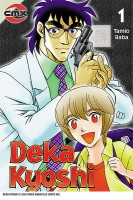 Deka Kyoshi, vol. 1
Deka Kyoshi, vol. 1
By Tamio Baba
Rated T+, Teen Plus
CMX, $9.99
Detective Toyama is a big, bumbling, good-hearted guy, so when his superiors suspect a schoolteacher has been murdered, they send him undercover as the new teacher for her class. It sort of works, because he obviously loves kids, but Toyama tends to lead with his heart, not his head.
Well, actually, he does lead with his head on the first day of school—hearing a child being bullied, he rushes into the classroom and hits his head on the top of the door frame, leaving a visible head-shaped dent. That’s the only bit of slapstick in the story, though. Although the cover suggests a comedy, Deka Kyoshi is more of a series of moral tales, with a central mystery knitting them loosely together.
The mystery has to do with the first teacher’s death—she fell from a roof, so her students assume she committed suicide, and several of them blame themselves or each other. It’s not clear what Toyama is looking for, but he gets an assistant early in the book: Makoto, one of his fifth-graders, who can see people’s emotions as physical forms. To Makoto, a bully appears as a spiky monster, a girl who doesn’t want to grow up looks like a giant stuffed doll. It’s all pretty basic, although the alternate personalities, called synthes, are well conceived and well drawn.
Makoto’s abilities make him shrink from others, and that in turn makes him a target for bullies—he was the child Toyama heard being bullied in the beginning of the book. After Toyama rescues him, the two hit it off, and Makoto starts helping Toyama. But not with the case of the falling teacher—that case is forgotten as the book turns episodic and Toyama and Makoto start solving the other students’ problems.
In addition to Makoto, Toyama has another ally—Narita-sensei, the school doctor, who is also something of a psychologist. She is cool and logical, proposing sensible solutions and countering Toyama’s hotheadedness. If anything she is too cool, often offering advice that is so laid-back as to be useless. When Toyama gets frustrated that his class is all reading manga instead of paying attention, Narita advises him not to confiscate the offending books. “Being a hardnose about it will have the opposite effect,” she says. “The best thing to do is take time to persuade them that their time here is better spent paying attention.” Like that’s going to work with a classroom full of fifth-graders.
And indeed, the solutions proposed to the students’ problems are too simplistic. In the manga story, a student has been shoplifting manga so he can share it with the class and thus become popular. Narita catches him and makes him promise not to do it any more. Of course the kid backslides, and Toyama yells at him to be a man and stop stealing. The student’s synth disappears and he gives up shoplifting for good. With similar ease, Toyama, Narita, and Makoto manage to cure a girl who cuts herself and another girl who is uncomfortable with her changing body. The stories are nice little self-contained dramas, but they never veer far from the predictable. There does seem to be a dark figure lurking in the shadows who may be causing bad thigs to happen—and by implication may have something to do with the teacher’s death—but that possibility goes unexplored in this volume.
The art in Deka Kyoshi is clean-lined and clear, with a fair amount of exaggeration. People more knowledgeable than me have described it as old-style shonen, ad that does seem to fit, but it’s an accessible style that either girls or boys can enjoy. The synthes are nicely drawn, and creator Tamio Baba does a nice job of using physical forms to describe emotional states.
At about 160 pages, this volume feels a little skimpy, but there are a few extras—a color page in front, a two-page bonus comic in the back. The cover is bright and appealing, although it implies a wackiness that isn’t really present in the book. With its simple stories and clear art, Deka Kyoshi does feel like it is pitched more toward the middle grades than adults, and it will probably have the most appeal for that age group.
This review is based on a review copy supplied by the publisher.
[…] covered Here’s to Suzie! and Read About Comics looked at Monsters. MangaBlog also covered Deka Kyoshi, which has a slightly different premise I enjoyed learning about. (I know. It’s probably […]